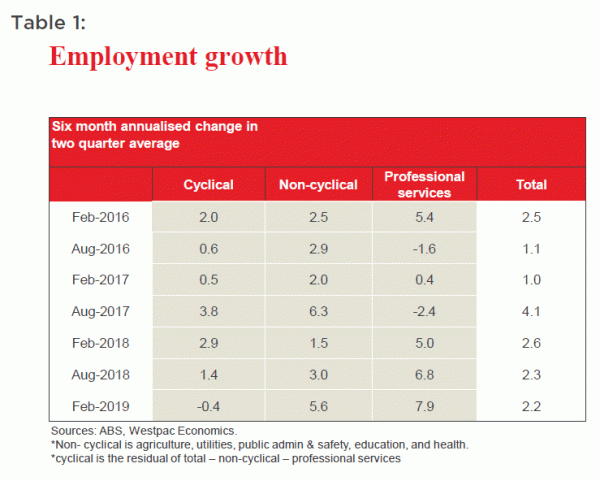The minutes of the April monetary policy meeting of the Reserve Bank Board have provided the clearest signal yet that the Bank would be prepared to cut the cash rate.
Firstly, the final section “Considerations for Monetary Policy” states “a lower level of interest rates could still be expected to support the economy through a depreciation of the exchange rate and via reducing required interest payments on borrowing, freeing up cash for other expenditure”.
The Board even sets out the conditions for a rate cut, “members also discussed the scenario where inflation did not move any higher and unemployment trended up, noting that a decrease in the cash rate would likely be appropriate in these circumstances”.
Recently the latest quarterly breakdown of employment by industry printed for the year to February.
We have considered this industry breakdown to try to find some insights into the RBA’s “tension” between the GDP and Employment Reports.
For a start it is reasonable to separate out the employment data into “cyclical” and “non-cyclical” sectors.
We have looked at “non-cyclical” covering: public administration; education and training; health care; and utilities.
Cyclical sectors are considered to be the other thirteen including: construction; manufacturing; retail and wholesale trade; accommodation; transport; finance; mining; real estate; recreation; and media.
The “non-cyclical “group has increased as a proportion of total employment from 27.9% in February 2008 to 31.9% in February 2019. That 4% increase in share represents 510,000 jobs in today’s workforce.
The cyclical group has fallen as a proportion of the workforce from 64.6% in February 2008 to 59.4% in February 2019.
It is important to note that “public administration” has increased by 18% over the last year but we assess that a considerable part of that increase has been due to reclassification of health and education workers from “private” to “public”.
Because we are including public; education; and health in the noncyclical category the reclassification does not distort the results.
Finally we have one remaining category – “professional services”. This group represents 8.7% of total employment covering: management consulting; computer system design; accounting services; legal services; and engineers. This category represents 8.7% of total employment having increased from 7.4% in February 2008.
Consider Table 1 to assess whether there has been any evidence of the impact of the slowdown in growth in the economy on employment. The table uses the six month annualised growth rate for jobs in the three categories (using a two quarter average to smooth the series).
The following observations are relevant:
- As noted by the RBA, overall momentum in the jobs market has held fairly steady over the last 18 months despite the slowdown in economic growth (2.6% in the six months to February 2018 to 2.2% in the last six months).
- However, momentum in the “cyclical” sectors has slowed markedly from 2.9% in the six months to February 2018 to –0.4% in the six months to February 2019.
- Momentum in the “non-cyclical” sectors has lifted considerably from 1.5% to 5.6% over the same period.
- The professional services sector has been booming.
So the “puzzle” about the labour market is not as opaque as might be expected. Non-cyclical jobs (dominated by government) have been strong and this sector is increasing as a proportion of total employment. Cyclical sectors are slowing markedly and are falling as a proportion of total employment. Given the lags and the cautious outlook for growth, employment in these sectors is likely to continue to slow.
It is not clear whether the “professional services” sector best fits in the cyclical or the non-cyclical categories. Certainly, strong government spending in the infrastructure space is likely to explain a considerable part of the success of this category; the sharp lift in government regulations is also supporting this sector. Furthermore, there is also likely to be a structural element to the success of this sector as companies embrace technology to boost productivity and substitute labour.
Conclusion
The Board of the RBA has nominated the labour market as the key for the policy outlook. We are disappointed that ongoing low inflation and the persistent need to lower growth forecasts seems to be out-weighed by the employment “story”.
Our analysis points to a marked slowdown in jobs growth already being well underway in the cyclical sectors of the economy.
We expect that eventual recognition of these facts will keep the RBA on track for our expected first rate cut in August.














